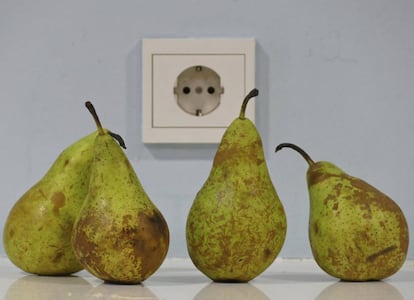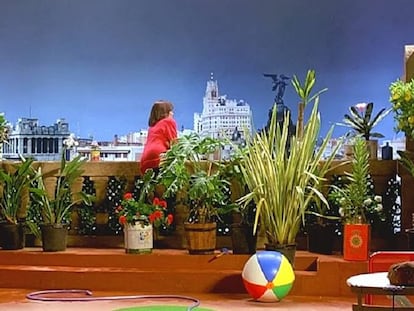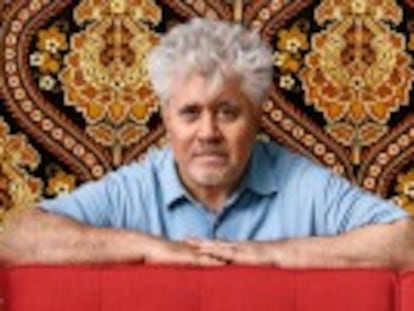Spanish movie legend Pedro Almodóvar puts out a different kind of picture
The director of ‘Volver’ and ‘Talk to her’ is staging a second exhibition of his still-life photography ahead of his new film project


Spanish filmmaker Pedro Almodóvar spent much of 2017 holed up inside his office, writing the screenplay for his upcoming movie Dolor y gloria (Pain and Glory), which is set to reunite some of his past cast members Penélope Cruz and Antonio Banderas.
“I try to shut everything out so nothing will distract me from my writing; for instance I listen to music without lyrics, so they will not get in the way,” explains the 69-year-old director of some of Spain’s most internationally acclaimed movies, including Talk to Her, Volver, and the 1980s comedy classic Women on the Verge of a Nervous Breakdown.
I like films about movie directors in crisis
Pedro Almodóvar
During the entire time that he spent on the script, Almodóvar has allowed himself one form of entertainment: photography. This art often crops up in his films, yet he himself had never tried his hand at it.
Using just two backgrounds – the view to the left from his office chair, and a window and electrical socket in the kitchen – Almodóvar began creating still-life compositions using decorative elements in his house.
“I used photography like anxiety medication while I was taking breaks from the screenplay,” he confesses.

The results of that work first went on display in September at La Fresh Gallery, where proceeds from sales went to charitable organizations. Now, Almodóvar’s photographs are up again at the Marlborough gallery as part of the PHotoEspaña photography festival.
“I don’t want to call it a hobby because I don’t practice it, and I don’t have high aspirations with this either,” says Almodóvar, sitting in a room adjoining the exhibition space. Above all, he defends “the narrative power of photography,” which is the reason it is always present in his films.
“I find photographs a lot more evocative than videos or the old Super-8 films,” he says. “They contain a great mystery. Time plays in favor of the expressive content of photographs, giving it new meanings.”
Joy and relief
Pedro Almodóvar defines himself as “perplexed” by the events of recent days in Spain, where a no-confidence vote unseated conservative prime minister Mariano Rajoy and replaced him with the Socialist Pedro Sánchez.
“Because I am in pre-production, I haven’t been able to keep up with the news very closely, but I do feel that with every passing day, something new and very important is taking place,” he says with a smile.
“Let’s be clear, these are not comparable events: we are not emerging from a dictatorship, yet I am overcome by similar feelings as when Franco died: joy, relief. And I remember perfectly where I was at both of those moments.”
“Many of the photos that show up in my movies also have great sentimental value, like the shot of Pina Bausch at the head of Leonor Watling’s bed in Talk To Her,” he explains. “In general, I show portraits that have something to do with me.”
The name of the exhibition is Vida detenida, the literal translation of “still life” (the artistic genre is known in Spanish as bodegón). “I use flowers, vases, objects within my reach. It is very satisfying because these are my things, and I feel that they are talking to me. But it’s just a form of entertainment, I cannot presume to rival the use of flowers by people such as Robert Mapplethorpe, for instance.”
Almodóvar reveals that he used a digital camera and natural light, and did not touch up his work at all. “I create pretty, pleasant compositions that are easy to live with,” he says, laughing before the inevitable question crops up: “Exactly the opposite of my films, which are unsettling, based on provocation, on the sense of questioning things.”
Still life
Although still life is a genre that has been practiced by artists across Europe, it has a place of honor in Spanish art, and Almodóvar wanted to pay tribute to that.
“From Sánchez Cotán, whose still-life works are well represented at the Prado, to Zurbarán, I think that all painters have tackled this genre at some point. Picasso, Antonio López... I would like to underscore that most of them captured moments in life, not dead things, and that is the meaning of my exhibition title. I feel very influenced by Antonio López, by his hyper-realism and portraits of solitude. This solitude is the genesis for my new project.”
A drama, Pain and Glory follows a film director played by Antonio Banderas in his waning years. “I like films about movie directors in crisis,” says Almodóvar, mentioning Fellini’s 8½ and Truffaut’s Day for Night. Shooting will begin in mid-July. “But the movie bears no relation to these pictures,” he warns.
English version by Susana Urra.
Tu suscripción se está usando en otro dispositivo
¿Quieres añadir otro usuario a tu suscripción?
Si continúas leyendo en este dispositivo, no se podrá leer en el otro.
FlechaTu suscripción se está usando en otro dispositivo y solo puedes acceder a EL PAÍS desde un dispositivo a la vez.
Si quieres compartir tu cuenta, cambia tu suscripción a la modalidad Premium, así podrás añadir otro usuario. Cada uno accederá con su propia cuenta de email, lo que os permitirá personalizar vuestra experiencia en EL PAÍS.
¿Tienes una suscripción de empresa? Accede aquí para contratar más cuentas.
En el caso de no saber quién está usando tu cuenta, te recomendamos cambiar tu contraseña aquí.
Si decides continuar compartiendo tu cuenta, este mensaje se mostrará en tu dispositivo y en el de la otra persona que está usando tu cuenta de forma indefinida, afectando a tu experiencia de lectura. Puedes consultar aquí los términos y condiciones de la suscripción digital.
More information
Archived In
Últimas noticias
Most viewed
- Reinhard Genzel, Nobel laureate in physics: ‘One-minute videos will never give you the truth’
- Pablo Escobar’s hippos: A serious environmental problem, 40 years on
- Charles Dubouloz, mountaineering star, retires at 36 with a farewell tour inspired by Walter Bonatti
- Why we lost the habit of sleeping in two segments and how that changed our sense of time
- The Florida Keys tourist paradise is besieged by immigration agents: ‘We’ve never seen anything like this’










































